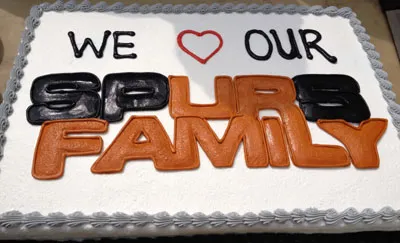You won’t find customers more loyal than in the sporting world. Many fans are notoriously devoted to their teams, often for their entire lives. They invest countless amounts of time, money, and energy to their teams. The level of loyalty sports teams have with fans is often the envy of other industries looking to build engagement.
We asked customer experience executives at a number of top sports franchises what they do to build loyalty momentum and keep fans engaged, regardless of how well the team performs. Here are some best practices from some of North America’s most successful teams, which can be applied to any industry.
San Antonio Spurs corporate family elevates the fan experience
Long before the San Antonio Spurs climbed their way to the top of professional basketball, winning last year’s National Basketball Association (NBA) championship title with the best winning percentage in NBA history, the team quietly celebrated a different kind of win—a service score exceeding 90 percent.
The organization scored high points with fans through an enterprisewide service transformation that appoints everyone in charge of the fan experience and aims to treat all employees like family. This approach to service delivery and fan engagement has resulted in an elevated fan experience and a steady rise in service scores for the past four years.
Getting this enterprisewide approach to service off the ground didn’t happen overnight. According to Rebecca Caven, senior director of service innovation at the Spurs, the organization started its shift toward service innovation in 2010, but such a mindset change takes time. “We decided we wanted a service culture where everyone in the organization viewed themselves as service professionals,” she says. “Whether you’re in finance or sales, at the end of the day, the actions that you take impact what that experience looks like.”
A working group was created, made up of Spurs President Gregg Popovich and vendors including catering, retail facilities services, parking, and usher services. The group created what it calls “FAMILY” values to represent new service standards: Friendly greeting, Arena awareness, Making memories, Image impact, Look and listen, Your 100%.
The next phase of the service transformation focused on training, coaching, and development. The organization’s leadership received presentation and training skills to recognize and reward employees in meaningful ways. The training program was then rolled out to the building staff with informational FAMILY guides and FAMILY pins for each employee. They also provided customer service skills training that touched on a variety of topics from how to guide guests to their seats to tips for actionable service delivery.
The Spurs also created a Service Innovation Department in January 2011. It holds weekly meetings to discuss potential areas of service innovation. The group sends out a notification to all employees and partners before each meeting seeking agenda items. Caven explains that the process aims to ensure folks participating in the meetings feel like they have a voice and an outlet for solving problems. During the meetings, the team brainstorms ideas on how to improve the fan experience before and after events.

One of the first suggestions from the meetings involved increasing the organization’s engagement level among individual game purchasers who aren’t season ticket holders or premium clients. Now after fans purchase their tickets, the Spurs sends email messages highlighting places to eat in the arena and informing them of events occurring near the arena that may impact them on game day. “We like to keep them informed before and after they come to the arena,” Caven says. After the event, the Spurs sends a thank-you notification with a survey attached to detail their experience before, during, and after the event. In addition, a “Text for Care” program allows fans to text a short code during events to interact with the staff if they have questions or concerns.
Caven also notes it’s important to celebrate fans’ milestones. Attendants deliver goodie bags filled with t-shirts, hats, or pendants to seats of fans celebrating birthdays or anniversaries. If it’s a child’s first game, attendants present them with a “My First Game” certificate. “We try to arm staff with the unexpected to make someone’s day,” Caven explains.
The organization equips the elevator attendees with stickers and pens to distribute to unsuspecting passengers, and empowers the ushers to perform service recovery. So if they see a guest drop his drink, they can reach out to concessions to replace it. Caven says in the past, concessions would refuse to replace those items, but because everyone’s mindset has changed and they’re all empowered to work together toward optimizing the fan experience, they’re all thinking, ‘how can we make the experience better?’”
To gauge the effectiveness of the organization’s service delivery, the team conducts two or three mystery shops per event. Mystery shoppers evaluate the entire experience—from the sound and music to food and service. The system generates 30-page reports that the Spurs use to spot trends and recognize employees doing a good job. So far, scores have been on a steady incline. The first season following the start of FAMILY Values, the average service score totaled 89 percent, the next season it increased to 90 percent, the following jumped to 91 percent, and at the beginning of this year it totaled 92 percent. This year the organization hopes to achieve a 94 percent goal and Caven says so far the monthly average has been totaling 95 percent.
The organization also plans to continuously evolve its service innovation efforts and FAMILY Values with the launch of a new app this spring. It will be a platform for fans to give feedback during games about their experiences. It will also provide a forum for fans to publicly recognize staff who go above and beyond for fans.
Celebrating employee successes is the key to the Spurs’ FAMILY Values maintaining momentum. The organization continuously recognizes these wins in briefings, at annual training events, and in meetings. Recently, to increase a sense of ownership in solving issues for the organization, Popovich decided to celebrate everyone’s efforts by giving all employees in the building $50 gift cards. And after last season’s championship win, Popovich bought all full-time staff a championship ring, which Caven says reinforces their value to the organization. “It’s not the things you say; it’s what you do,” she says. “You’re either a company that really cares about people or just talks about it. The more you do for them, the more you do for the experience of the fans.”
Going mobile to engage fans in Toronto
Maple Leaf Sports and Entertainment (MLSE) understands that to cultivate strong customer relationships, its sports teams must engage their fans wherever they are. One of Canada’s leading sports and entertainment organizations, MLSE owns the NHL’s Maple Leafs, AHL’s Toronto Marlies, NBA’s Toronto Raptors, and Toronto FC of Major League Soccer.
MLSE has mainly relied on email to keep fans updated on upcoming games, ticket offers, and special events. But to keep up with its increasingly hyper-connected audience, MLSE is expanding its marketing toolset to include enhanced mobile apps and social media features, says Business Intelligence Manager Robert Craig.
“We know there are lots of ways to reach our fans and we want to make sure we’re providing them with value-added experiences,” Craig says. “So regardless of whether someone is at home or at the stadium, we want to make that experience relevant and something they wouldn’t get unless they interacted with us.”

One of the initiatives includes leveraging location data to offer mobile contests that fans can only access during game time or when they’re at a stadium. MLSE is also partnering with Cisco to provide Wi-Fi access in the stadium and instant replay capabilities on smartphones. Fans watching at home may get a different experience, such as contests tailored for those watching the game on TV. “We’re not quite there yet, but this could be another way to customize the fan experience,” Craig says. Additionally, when fans log in to an MLSE mobile app, the organization is planning to connect the user data from its mobile apps with its CRM database to create a more seamless experience.
MLSE is also seeing more fans engaging with the teams through social media. The Toronto Maple Leafs’ Twitter account (@MapleLeafs) has the highest number of new followers in the NHL. Toronto Raptors point guard Kyle Lowry even received votes on Twitter from Canada’s Prime Minister Stephen Harper and Toronto Mayor John Tory for a spot in the NBA All-Star Eastern Conference in February (he won the spot). MLSE’s goal is to further engage its fans on social media by identifying active followers as well as dormant fans, says Craig.
MLSE’s road map also includes a greater focus on real-time insights and data science to identify more opportunities to engage fans as well as make faster decisions.
Boston Red Sox, Cleveland Cavaliers innovate around customer engagement
Connecting data from various channels presents challenges, but doing so can yield a more complete customer profile. Meghan Ryan, marketing and social media specialist for the Boston Red Sox, says her organization’s goal is to consolidate customer data points and provide a seamless fan experience.
“A big priority for us in 2015 is to make sure that we have a 360-degree profile of our fan base so we can better serve our fans and reward them for their interactions with the team and their attendance, viewing habits, and social habits,” Ryan says. Some of the data points include social data about fans, ticket transactions, and email subscriber lists. The company is investing in social CRM technology, among other solutions, to pull insight from the data collected.
Drawing more fans to Fenway Park is another priority. Many of the giveaways in 2015 will be aimed at children to help grow the Red Sox’s next generation of loyal fans, such as mascot bobbleheads and lunch boxes. Overall, the team is focused on “getting smarter and developing new strategies for engaging fans wherever they are; online, watching TV, or in the ballpark,” Ryan says.
Michael Conley, vice president of digital for the Cleveland Cavaliers, says his focus is on mobile fan engagement. “We have more mobile traffic than we do desktop traffic now, so our production team, our designers and our developers are all focused on a mobile-first strategy for engaging our fans,” Conley says.
The Cavaliers recently added gamification to its mobile app. It presents users with questions about the game that’s taking place in real time. So if Kyrie Irving scores 12 points, that will trigger a question such as, “How many points will Kyrie Irving have at the end of the first quarter?” Conley explains. Fans who play with the app in the arena get the added bonus of seeing their names on huge leader boards that are displayed on screens in the arena.
Getting fans to share tweets and photos that are instantly displayed on the arena’s screens is another way to drive engagement and display fan loyalty. For instance, when long-time center Zydrunas Ilgauskas retired two years ago, fans were encouraged to submit congratulatory messages for him, which were displayed during an on-court ceremony. About 800 social posts from Facebook, Instagram, and Twitter were projected on the court while Ilgauskas spoke at the podium and more than 27,000 pieces of social content were generated the night of the ceremony.
Whether it’s user-generated content or produced by the brand, people will respond to strong content, Conley adds. “I am a firm believer in that, content first and then everything else follows,” he says.















